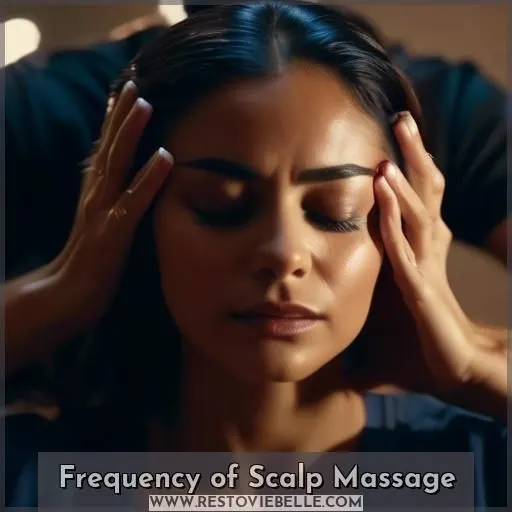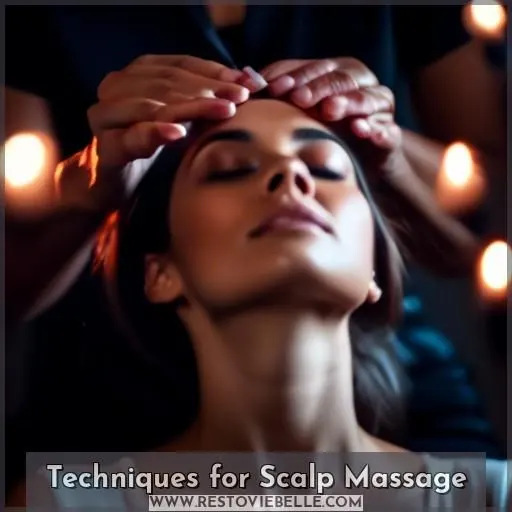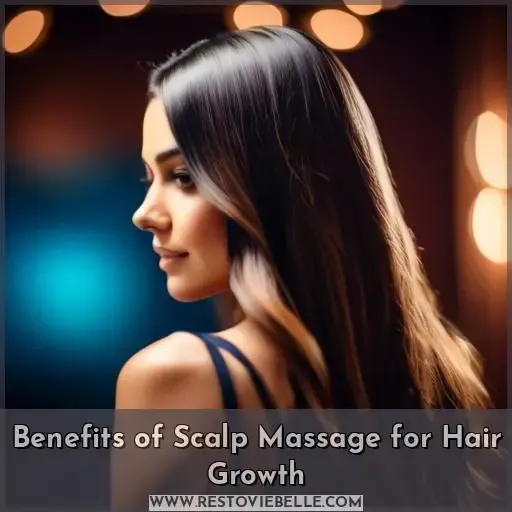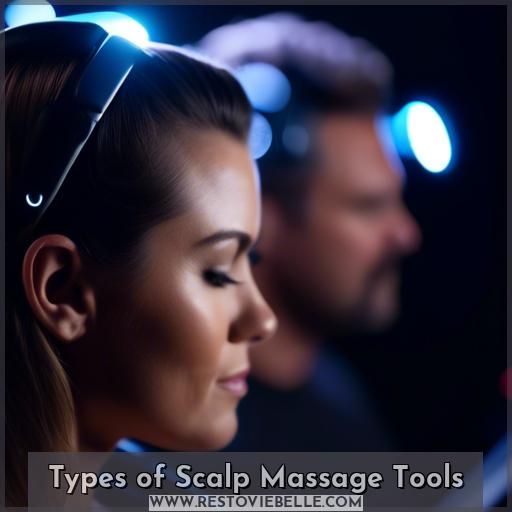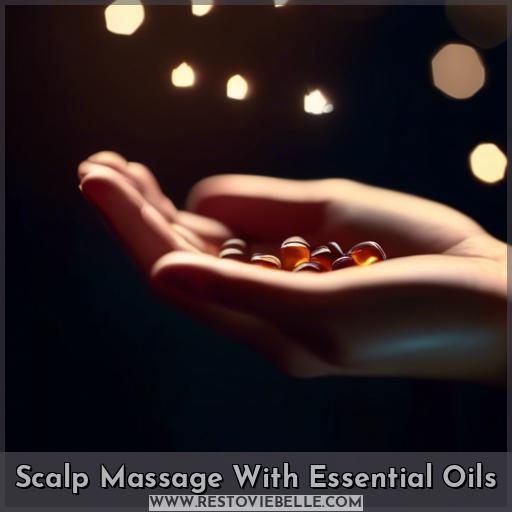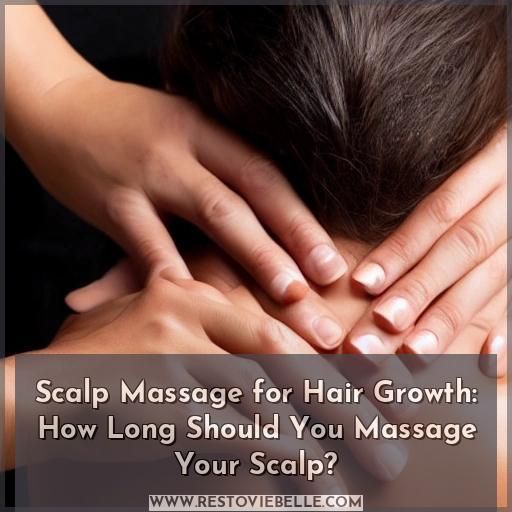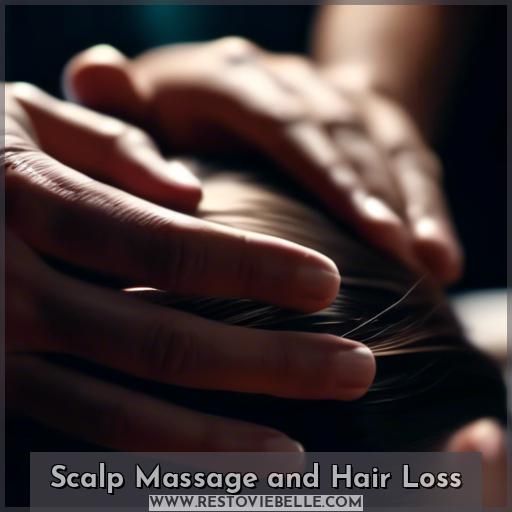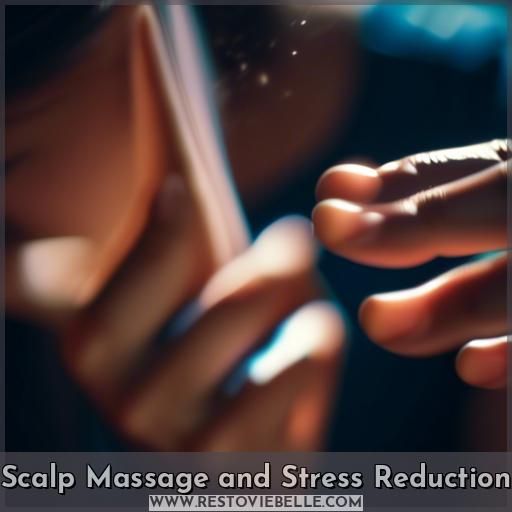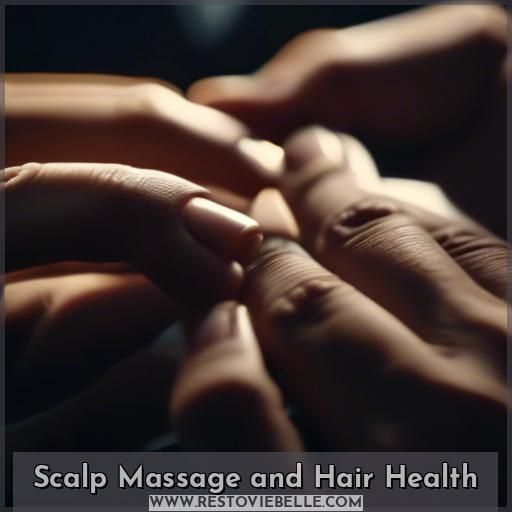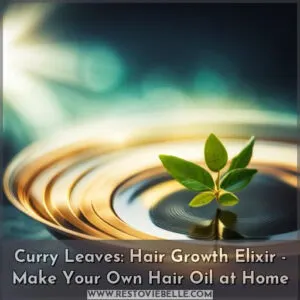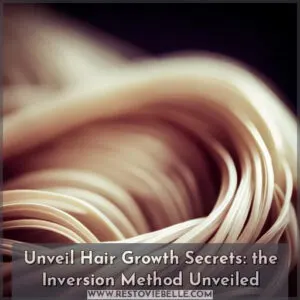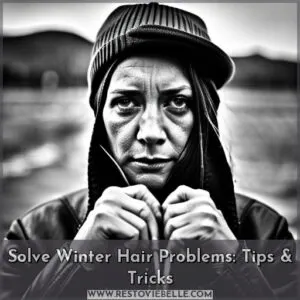This site is supported by our readers. We may earn a commission, at no cost to you, if you purchase through links.
 Unleash your hair’s radiant potential through the power of scalp massage.
Unleash your hair’s radiant potential through the power of scalp massage.
Caress your scalp’s delicate ecosystem, a haven nurturing each follicle’s growth.
Discover the optimal duration to elevate this ritual, empowering you with thicker, more vibrant tresses.
Embrace a transformative journey where every stroke unlocks nature’s bounty, a remedy for your mane’s vibrancy.
Table Of Contents
- Key Takeaways
- How Long Should You Massage Your Scalp?
- Frequency of Scalp Massage
- Frequency Depends on Individual Hair Type, Current Hair Health, and Scalp Condition
- Recommended to Massage Scalp Twice to Three Times a Week for Hair Growth
- For Relaxation, Massage Scalp as Desired
- For Dandruff Removal, Massage Scalp With Anti-dandruff Shampoo While Bathing
- For Stress Relief, Massage Scalp for at Least 5 Minutes Several Times a Day
- Avoid Over-massaging or Using Oil Daily
- Techniques for Scalp Massage
- Traditional Scalp Massage: Use Fingertips to Apply Light to Medium Pressure in Small Circles
- Massage While Washing Hair: Gently Rub in Shampoo With Circular Motions for 5 Minutes
- Brushes and Massage Tools: Use Scalp Massagers or Brushes to Cover All Areas of the Scalp
- Scalp Massage With Essential Oils: Mix 1-2 Drops of Oil With 1 Tablespoon of Carrier Oil and Apply to Scalp
- Do a Patch Test Before Applying Essential Oils to Scalp
- Benefits of Scalp Massage for Hair Growth
- Types of Scalp Massage Tools
- Scalp Massage With Essential Oils
- Scalp Massage for Hair Growth: How Long Should You Massage Your Scalp?
- Scalp Massage and Hair Loss
- Regular Scalp Massage May Promote Hair Growth, Prevent Hair Loss, and Improve Hair Thickness for Some People
- Scalp Massage May Help to Stretch the Hair Follicles, Spurring Them to Promote Faster, Thicker Growth
- In Some Cases, Scalp Massage May Not Be Effective for Individuals With Genetic or Hormonal Causes of Hair Loss
- Scalp Massage and Stress Reduction
- Scalp Massage and Blood Circulation
- Scalp Massage and Hair Health
- Frequently Asked Questions (FAQs)
- Conclusion
Key Takeaways
- Massaging your scalp for around 10-20 minutes at a time is effective in promoting hair growth.
- The frequency of scalp massage should be tailored to individual hair type, current hair health, and scalp condition, with a general recommendation of twice to three times a week for hair growth.
- Incorporating essential oils, such as lavender and peppermint, into your scalp massage can enhance the benefits, including promoting hair growth and providing relaxation.
- Regular scalp massage can improve blood circulation to the scalp, nourish and strengthen hair follicles, and may help prevent hair loss.
How Long Should You Massage Your Scalp?
To unlock thicker, healthier hair, the ideal duration for a scalp massage session can range from 5 to 15 minutes, depending on your needs and preferences.
Frequency of Scalp Massage
The frequency of scalp massage depends on your hair type, current hair health, and scalp condition. For hair growth, it’s recommended to massage your scalp twice to three times a week.
Frequency Depends on Individual Hair Type, Current Hair Health, and Scalp Condition
Finding the sweet spot for your scalp massage frequency is like hitting the jackpot for your hair’s health.
- Your scalp’s sensitivity and any existing conditions.
- The fragility of your hair strands.
- How different oils react with your scalp.
- The ultimate goal: boosting hair growth or tackling hair loss.
Tuning into your scalp’s needs can turn the tide in your hair’s favor.
Recommended to Massage Scalp Twice to Three Times a Week for Hair Growth
To achieve optimal hair growth, it is recommended to massage your scalp twice to three times a week.
The frequency of scalp massage should be tailored to your individual hair type, current hair health, and scalp condition.
This frequency is designed to enhance hair follicle cell growth, strengthen follicles, and improve blood flow to the scalp, all of which contribute to thicker, healthier hair.
When using a scalp massaging tool, be mindful of scalp sensitivity, hair porosity, hair condition, and scalp oiliness.
Massage duration should be at least 5 minutes, but not exceeding daily use to avoid over-massaging or using oil daily.
For Relaxation, Massage Scalp as Desired
For relaxation, massage your scalp as desired. The frequency of scalp massage depends on individual hair type, current hair health, and scalp condition. Regular maintenance treatments once every two weeks may be beneficial for those with a healthy scalp, while more frequent treatments may be necessary for those with scalp issues such as dandruff, dryness, or excessive oiliness.
For Dandruff Removal, Massage Scalp With Anti-dandruff Shampoo While Bathing
To effectively remove dandruff, massage your scalp with anti-dandruff shampoo while bathing. This won’t only cleanse your scalp and hair, but also improve blood flow and nourish your hair follicles.
- Use an electric scalp massager or your fingertips to apply light to medium pressure.
- Focus on pressure points for optimal results.
- Massage for at least 5 minutes to ensure thorough cleansing.
- Follow up with a volumizing shampoo and conditioner to enhance hair health.
For Stress Relief, Massage Scalp for at Least 5 Minutes Several Times a Day
For stress relief, massage your scalp for at least 5 minutes several times a day.
Scalp massage has been shown to reduce stress levels, which can contribute to hair loss in some individuals.
By incorporating essential oils, such as lavender and peppermint, into your scalp massage, you can enhance the experience and potentially promote hair growth.
Remember to use scalp massage tools, like brushes or handheld rubber massagers, to ensure a thorough massage.
It’s not merely about the duration, but also the method and tools used.
Avoid Over-massaging or Using Oil Daily
After unwinding with a scalp massage, remember, there’s too much of a good thing. Overdoing it or daily oil slathering can lead to scalp sensitivity and oil buildup, counteracting those lush locks you’re after.
Instead, balance is key. Explore other hair growth avenues like finasteride, minoxidil, laser therapy, hair transplants, or corticosteroid injections for a well-rounded approach to hair health.
Techniques for Scalp Massage
Scalp massages are a great way to promote hair growth, but how long should you massage your scalp for? Most studies show that massaging your scalp for around 10-20 minutes at a time is effective.
Traditional Scalp Massage: Use Fingertips to Apply Light to Medium Pressure in Small Circles
To unlock thicker, healthier hair, start with traditional scalp massage.
Use your fingertips to apply light to medium pressure, moving in small circles.
Cover all areas of your scalp for at least 5 minutes at a time.
Repeat several times a day, or as needed for relaxation.
It’s not merely a one-size-fits-all approach, but a bespoke journey toward improved hair growth.
Massage While Washing Hair: Gently Rub in Shampoo With Circular Motions for 5 Minutes
Massaging your scalp while washing your hair is a time-saving technique that can help remove dandruff and improve blood circulation. Gently rub in shampoo with circular motions for 5 minutes using your fingertips.
This massage can be done daily and is a great way to stimulate hair follicles and promote hair growth.
Brushes and Massage Tools: Use Scalp Massagers or Brushes to Cover All Areas of the Scalp
To unlock thicker, healthier hair, it’s essential to incorporate scalp massage into your hair care routine. One of the most effective ways to achieve this is by using scalp massagers or brushes. These tools are designed to mimic the pressure of fingertips, covering all areas of the scalp, and can be used all over the scalp. They come in various forms, such as brushes or handheld rubber massagers, and can be used with essential oils for added benefits.
Here are four ways to use scalp massagers or brushes for optimal results:
- Scalp Brush: A scalp brush is a great tool for exfoliating the scalp and removing buildup from dandruff flakes, dry skin, and dead skin cells. It also helps distribute shampoo throughout the scalp, providing a thorough cleanse.
- Scalp Massager: A handheld scalp massager can be used to stimulate blood flow to the scalp, bringing important nutrients to the hair follicle. It can also help reduce stress, which can contribute to hair loss.
- Fingertip Massage: For a more traditional approach, you can use your fingertips to apply light to medium pressure in small circles, covering all areas of the scalp. This method is also effective for promoting relaxation and relieving headaches and migraines.
- Essential Oils: Mix 1-2 drops of essential oils like lavender or peppermint with 1 tablespoon of carrier oil, then apply to the scalp and massage with fingertips or a scalp massager. Do a patch test before applying essential oils to the scalp to ensure compatibility.
Scalp Massage With Essential Oils: Mix 1-2 Drops of Oil With 1 Tablespoon of Carrier Oil and Apply to Scalp
To unlock thicker, healthier hair, you can incorporate scalp massage with essential oils into your hair care routine. Mix 1-2 drops of your chosen essential oil with 1 tablespoon of a carrier oil, such as jojoba, almond, avocado, or olive oil. Apply this mixture to your scalp and massage gently with your fingertips or a scalp massager. Some essential oils, like rosemary, geranium, lavender, peppermint, clary sage, tea tree, and cedarwood, can be particularly beneficial for hair growth and scalp health.
When selecting essential oils for your scalp massage, consider their benefits for your hair type. For example, rosemary oil can promote hair growth and strengthen hair, while lavender oil can help with relaxation and dandruff control. It’s essential to dilute essential oils with a carrier oil to avoid skin irritation and ensure the oil is safe for scalp use.
Remember to store your essential oils properly to maintain their quality and effectiveness. Keep them in a cool, dark place, away from direct sunlight and heat. By incorporating essential oils into your scalp massage routine, you can enhance the benefits of the massage and promote healthier, thicker hair.
Do a Patch Test Before Applying Essential Oils to Scalp
Before diving headfirst into the aromatic world of essential oils for your scalp, let’s play it safe with a patch test. Think of it as your skin’s first date with the oil; you wouldn’t want any unexpected allergic reactions ruining the mood.
Just a dab on the inside of your arm can save you from a scratchy, red disaster.
Benefits of Scalp Massage for Hair Growth
Scalp massage may promote thicker, healthier hair by increasing blood flow to the scalp, which nourishes and strengthens hair follicles. Regular scalp massage may also stimulate hair growth by increasing hair follicle cell growth and strengthening follicles to produce thicker hair.
Promotes Relaxation
Massaging your scalp isn’t only beneficial for hair growth, but it also promotes relaxation.
- Stress Relief: Scalp massage has been shown to reduce stress levels, which can contribute to hair loss in some individuals.
- Headache and Migraine Relief: Massaging your scalp can help alleviate headaches and migraines by improving blood flow and reducing tension.
- Improved Circulation: Scalp massage increases blood flow, delivering more oxygen and nutrients to hair follicles, promoting hair growth.
Relieves Headaches and Migraines
Regular scalp massages can provide relief from headaches and migraines.
They relax the muscles in the head, neck, and face, which can cause tension and pain.
Massaging these areas also improves circulation, allowing more oxygen and nutrients to reach the affected tissues.
Additionally, scalp massage can trigger relaxation and stress relief.
This can help alleviate the symptoms of headaches and migraines.
Improves Circulation
Massaging your scalp can significantly improve circulation, which is crucial for hair growth. By stimulating blood flow, your scalp receives more oxygen and nutrients, promoting healthier hair follicles.
This can lead to thicker, stronger hair and potentially even prevent hair loss. Additionally, scalp massage provides relaxation and stress relief, which can further contribute to overall scalp health.
Nourishes and Strengthens Hair Follicles
Nourishing and strengthening your hair follicles is a crucial step towards achieving thicker, healthier hair. Scalp massage plays a significant role in this process, as it increases blood circulation to the scalp, delivering essential nutrients and oxygen to the hair follicles. This, in turn, can stimulate hair growth and improve the overall health of your hair.
Here are four key ways that scalp massage can benefit your hair:
- Promotes Hair Growth: Regular scalp massage can stimulate hair follicles, promoting faster and thicker hair growth.
- Strengthens Hair Follicles: By increasing blood flow to the scalp, scalp massage can strengthen hair follicles, reducing the likelihood of breakage and promoting healthier hair.
- Improves Blood Circulation: Scalp massage helps to dilate blood vessels, improving blood flow to the scalp and delivering nutrients and oxygen to the hair follicles.
- Stimulates Hair Growth: The increased blood flow and oxygen supply to the hair follicles can stimulate hair growth, potentially preventing hair loss.
To maximize the benefits of scalp massage for hair growth, consider incorporating essential oils into your routine. Essential oils like rosemary, geranium, lavender, peppermint, clary sage, tea tree, and cedarwood have been shown to promote hair growth and strengthen hair follicles. Simply mix a few drops of your chosen essential oil with a carrier oil, such as coconut or jojoba oil, and apply the mixture to your scalp before massaging it in with your fingertips or a scalp massager.
In summary, scalp massage is a simple yet effective way to nourish and strengthen your hair follicles, promoting hair growth and overall hair health. By incorporating essential oils and finding a routine that suits your needs, you can unlock the secrets to thicker, healthier hair.
May Reduce Hair Loss
Continuing from nourishing your hair follicles, regular scalp massages might just be your ticket to waving goodbye to hair loss.
By dedicating time to scalp massage duration and technique, you’re not only pampering your scalp but potentially preventing hair loss.
Choose your essential oils wisely.
Increases Hair Follicle Cell Growth
Embrace the power of scalp massage to unlock thicker, healthier hair.
By massaging your scalp, you’re not only promoting relaxation and relieving headaches, but also increasing hair follicle cell growth.
This stimulates hair growth, strengthens follicles, and improves blood flow to the scalp.
Essential oils like lavender and peppermint can enhance these benefits.
For optimal results, massage your scalp twice a day, using fingertips or a scalp massager.
Strengthens Follicles to Produce Thicker Hair
To produce thicker hair, scalp massage is crucial.
By stimulating hair follicles, dilating blood vessels, and increasing blood flow, scalp massage can improve hair growth and potentially prevent hair loss.
Traditional scalp massage, massage while washing hair, brushes and massage tools, and scalp massage with essential oils are all effective methods.
Frequency depends on individual needs.
Recommendations are for twice to three times a week for hair growth and as desired for relaxation.
Improves Blood Flow to the Scalp
Massaging your scalp regularly can improve blood flow to the area, which is essential for hair growth.
By dilating blood vessels and stimulating follicles, massaging can increase the potential for hair growth.
For hair growth, it’s recommended to massage your scalp twice to three times a week.
For relaxation, massage as desired.
For dandruff removal, massage with anti-dandruff shampoo while bathing.
For stress relief, massage for at least 5 minutes several times a day.
Avoid over-massaging or using oil daily.
The frequency of massaging depends on your hair type, current health, and scalp condition.
Stimulates Hair Growth
Massaging your scalp can stimulate hair growth and help prevent hair loss. Regular scalp massage may stretch the hair follicles, encouraging them to produce thicker, more voluminous hair. Some studies suggest that daily scalp massage can lead to increased hair follicle cell growth and improved blood flow to the scalp, which may stimulate hair growth. Additionally, scalp massage may help reduce stress levels, which can contribute to hair loss in some individuals.
To massage your scalp for hair growth, use your fingertips to apply moderate pressure in small circles across your entire scalp for five to 20 minutes. You can also use scalp massaging tools, such as brushes or handheld rubber massagers, to cover all areas of your scalp. For optimal results, massage your scalp twice a day, but once a day may also be effective.
May Prevent Hair Loss
Just like watering a thirsty plant, scalp massage breathes life into your hair roots.
It’s your secret weapon against hair loss, with each rub and circular motion awakening dormant hair follicles.
Imagine the essential oils as your hair’s superfood, turbocharging the massage’s effectiveness.
This ritual isn’t just a treat; it’s a battle cry for hair loss prevention, ensuring every strand stands strong.
Types of Scalp Massage Tools
Scalp massagers mimic the pressure of your fingertips. Some dermatologists recommend scalp massagers, while others believe fingertip massage is equally effective.
Scalp Massagers Mimic Pressure of Fingertips
When it comes to scalp massage tools, scalp massagers are the real deal.
They mimic the finger pressure you’d get from a skilled massage.
These tools work wonders, replicating the benefits of fingertip massage with precision.
They’re like having a personal masseuse at your fingertips.
They deliver that perfect scalp pressure for a relaxing and effective massage experience.
So, why settle for less when you can have the best?
Some Dermatologists Recommend Scalp Massagers
When it comes to scalp health, dermatologists often recommend scalp massagers as an effective technique.
These tools mimic the pressure of fingertip massage, offering a convenient way to stimulate the scalp.
Whether you opt for a brush or handheld massager, these devices can enhance blood circulation and promote relaxation.
Incorporating scalp massagers into your routine can unlock the secrets to healthier, thicker hair effortlessly.
Others Believe Fingertip Massage is Equally Effective
| Fingertip massage is believed to be as effective as scalp massagers by some experts. While tools mimic fingertip pressure, traditional techniques using your fingertips can work wonders. Imagine the gentle circles of your fingertips stimulating hair growth. It’s like a personal touch that your scalp craves, unlocking the potential for healthier, thicker hair. Embrace the simplicity and power of fingertip massage for a liberating hair care experience. | Unlock Thicker, Healthier Hair | |
|---|---|---|
| Fingertip Massage | Equally Effective | Personal Touch |
| Mimics Pressure | Traditional Technique | Stimulates Growth |
Scalp Massaging Tools Come in Brush or Handheld Rubber Massager Form
When it comes to scalp massage tools, the options are diverse, ranging from brushes to handheld rubber massagers.
While some swear by the effectiveness of scalp massagers, others find fingertip massages equally beneficial.
These tools not only enhance relaxation through scalp massage but also offer unique benefits for hair health.
So, whether you opt for a brush or a massager, unlocking the secrets to healthier hair is within reach.
Can Be Used All Over Scalp
When it comes to scalp massage tools, versatility is key. Scalp massagers, whether in brush or handheld rubber form, can be your go-to for a full scalp treatment.
- Reach every corner effortlessly.
- Stimulate hair growth effectively.
- Enhance scalp circulation for optimal blood flow.
- Aid in preventing hair loss with thorough stimulation.
Scalp Massage With Essential Oils
If you’re seeking thicker, healthier hair, incorporate essential oils into your scalp massage routine. Mix a few drops of lavender or peppermint oil with a carrier oil, then massage the blend into your scalp for a nourishing and stimulating treatment.
Lavender and Peppermint Oils May Promote Hair Growth
Lavender and peppermint oils, known for their hair growth benefits, are key players in scalp massage. Lavender oil, with its soothing aroma, and peppermint oil, invigorating and refreshing, work wonders for your hair.
When these oils meet your scalp during a massage, they stimulate growth and nourish your follicles.
Mix 1-2 Drops of Oil With 1 Tablespoon of Carrier Oil
To unlock the secrets of scalp massage for hair growth, it’s essential to understand the right techniques, oils, and frequency.
Mixing 1-2 drops of essential oil with 1 tablespoon of carrier oil is a simple yet effective DIY scalp treatment.
This blend can be applied to your scalp and massaged with fingertips or a scalp massager.
Lavender and peppermint oils are popular choices for promoting hair growth, as they improve blood circulation and stimulate hair follicles.
Always remember to do a patch test before applying essential oils to your scalp to avoid any adverse reactions.
Apply to Scalp
To apply essential oils for scalp massage, follow these steps:
- Mix 1-2 drops of your chosen essential oil with 1 tablespoon of a carrier oil.
- Apply the diluted essential oil mixture to your scalp.
- Gently massage the oil into your scalp using your fingertips or a scalp massager.
- For optimal results, massage for at least 5 minutes, ensuring you cover all areas of your scalp.
Massage With Fingertips or Scalp Massager
When it comes to scalp massage, the duration matters!
Whether you opt for fingertips or a scalp massager, aim for around 10-20 minutes per session to unlock those luscious locks.
Dilute essential oils properly.
Mix 1-2 drops with a carrier oil, and massage away.
Find your perfect pressure balance with fingertip versus massager techniques.
Consider a daily massage routine for optimal hair health.
Scalp Massage for Hair Growth: How Long Should You Massage Your Scalp?
There’s no one-size-fits-all answer to how often and for how long you need to massage your scalp for hair growth. Most studies demonstrate that massaging your scalp for around 10-20 minutes at a time is effective in promoting hair growth.
There is No One-size-fits-all Answer to How Often and for How Long You Need to Massage Your Scalp for Hair Growth
After diving into the world of essential oils, let’s tackle the big question: how often and long should you massage your scalp for hair growth? There’s no cookie-cutter answer—it’s all about listening to your hair type, current hair health, and scalp condition.
- Every scalp is a unique universe.
- Your hair’s needs are as individual as your fingerprints.
- Patience and consistency are your best pals.
- Embrace the journey to luscious locks.
Most Studies Demonstrate That Massaging Your Scalp for Around 10-20 Minutes at a Time is Effective in Promoting Hair Growth
When it comes to promoting hair growth, the ideal scalp massage duration falls between 10 to 20 minutes. This sweet spot not only boosts hair growth but also enhances blood circulation, reduces stress, and offers relaxation benefits.
For Optimal Results, Massage Your Scalp Twice a Day
To optimize scalp health, boost hair growth, and combat hair loss, make it a habit to massage your scalp twice daily. This routine not only enhances blood circulation, promoting healthier follicles and thicker hair but also aids in stress relief.
Embrace this simple yet powerful practice to unlock the secrets of a healthier scalp and luscious locks.
Scalp Massage and Hair Loss
Regular scalp massage may promote hair growth and prevent hair loss for some individuals. Scalp massage may help stretch hair follicles, stimulating faster, thicker growth.
Regular Scalp Massage May Promote Hair Growth, Prevent Hair Loss, and Improve Hair Thickness for Some People
Regular scalp massage can promote hair growth, prevent hair loss, and improve hair thickness for some people.
By massaging your scalp, you may be able to stretch the hair follicles, spurring them to promote faster, thicker growth. However, scalp massage may not be effective for individuals with genetic or hormonal causes of hair loss.
To get the most out of your scalp massage, consider massaging your scalp twice a day for around 10-20 minutes at a time.
Additionally, maintaining scalp health and promoting hair growth requires a holistic approach. This includes incorporating hair-friendly foods into your diet, regular scalp massages, and scalp brushing.
Scalp Massage May Help to Stretch the Hair Follicles, Spurring Them to Promote Faster, Thicker Growth
Massaging your scalp may help to stretch the hair follicles, spurring them to promote faster, thicker growth.
This is because scalp massage can increase blood flow to the hair follicles, delivering more oxygen and nutrients to the hair.
Additionally, massage can help to reduce stress levels, which can be a contributing factor to hair loss in some individuals.
By incorporating scalp massage into your hair care routine, you may be able to unlock thicker, healthier hair.
In Some Cases, Scalp Massage May Not Be Effective for Individuals With Genetic or Hormonal Causes of Hair Loss
If you’re dealing with genetics or hormonal hair loss, scalp massage might not be the magic bullet you’re seeking. While it can promote relaxation and improve circulation, it may not be as effective for those with more complex hair loss issues.
It’s essential to remember that everyone’s hair journey is unique, and what works for one person might not work for another. If you’re unsure about your hair loss, consult a professional to explore other options, such as finasteride or minoxidil, which have been clinically proven to treat male pattern baldness.
Scalp Massage and Stress Reduction
If you’re experiencing stress, scalp massage may be a great way to reduce those feelings. Relieving stress can positively affect your hair, preventing hormonal changes that could impact its overall health.
Scalp Massage May Help to Reduce Stress Levels, Which Can Be a Contributing Factor to Hair Loss in Some Individuals
Scalp massage can be a powerful tool for reducing stress levels, which can be a contributing factor to hair loss in some individuals.
Reducing Stress Levels Through Scalp Massage Can Help to Prevent Hormonal Changes That Can Affect the Health of Your Hair
| Reducing stress through scalp massage aids in maintaining hormonal balance, crucial for optimal hair health. This relaxation technique not only soothes your mind but also stimulates your scalp, promoting healthier hair growth. By incorporating stress management into your routine, you unlock the secrets to vibrant hair. Remember, a relaxed mind leads to a healthy scalp and luscious locks! | Unlock Thicker Hair | Promote Hair Health | Stress-Free Scalp |
|---|---|---|---|
| Soothe Your Mind | Stimulate Hair Growth | Relax and Rejuvenate |
Scalp Massage and Blood Circulation
Massaging your scalp improves blood circulation, delivering oxygen and nutrients to your hair follicles. This increased blood flow helps remove waste products and toxins that can block hair growth.
Scalp Massage May Improve Blood Circulation to the Scalp, Delivering More Oxygen and Nutrients to the Hair Follicles
Imagine your scalp as a bustling metropolis, with blood vessels like highways transporting vital nutrients to the hair follicle neighborhoods. A good scalp massage ramps up traffic flow, bringing a surge of life-giving oxygen and nutrients.
This boost in circulation can enhance follicle growth and improve scalp elasticity, laying down the red carpet for a fuller, healthier mane.
Increased Blood Flow Can Also Help to Remove Waste Products and Toxins That Can Build Up on the Scalp and Block Hair Growth
When you rev up that scalp stimulation, you’re not just boosting blood flow.
You’re also kickstarting a cleanup crew.
Increased circulation nourishes hair follicles.
It also sweeps away waste products and toxins that can clog up your scalp and stunt hair growth.
It’s like giving your scalp a refreshing detox.
Ensuring those locks get the VIP treatment they deserve.
Scalp Massage and Hair Health
Regular scalp massages can promote hair growth and prevent hair loss. You should massage your scalp for around 10-20 minutes at a time, twice a day, for optimal results.
Promoting Healthy Hair Growth Requires a Holistic Approach That Includes Incorporating Hair-friendly Foods Into Your Diet, Regular Scalp Massages, and Scalp Brushing
To unlock thicker, healthier hair, embrace a holistic approach blending hair-friendly foods, regular scalp massages, and scalp brushing. Nourish your scalp with the right diet, invigorate it with massages, and keep it healthy with gentle brushing.
This trio promotes scalp health, boosts hair growth, and combats hair loss effectively.
Avoiding Heat Styling, Getting Regular Trims, and Using Hair-friendly Products Can Also Contribute to Healthy Hair Growth
To maintain healthy hair growth, steer clear of heat styling, opt for regular trims, and choose hair-friendly products. Embrace a balanced diet, a solid hair care routine, and stress-busting exercises.
Consider vitamin supplements to boost hair health. Remember, your hair’s well-being is a reflection of your overall health.
Frequently Asked Questions (FAQs)
Can scalp massage prevent dandruff and itching?
Yes, scalp massage can prevent dandruff and itching. The massaging motion loosens flakes while increasing blood flow to nourish hair follicles.
Does scalp massage help with hair thickness?
You bet! Studies show massaging for just 4 minutes daily can increase hair thickness by 3-4%.
Are scalp massages beneficial for stress relief?
You bet! Scalp massages are an excellent way to de-stress and unwind. The gentle pressure relieves tension headaches while boosting blood flow for ultimate relaxation.
Can scalp massage improve hair follicle health?
Can scalp massage improve hair follicle health? Absolutely! Regular massaging stimulates blood flow, delivering vital nutrients to those precious follicles – the very foundation of luscious locks.
How does scalp massage impact blood circulation?
Scalp massage enhances blood flow, ensuring hair follicles receive vital oxygen and nutrients. The massaging motions dilate blood vessels, promoting circulation – a key factor for luscious locks.
Conclusion
You may doubt scalp massage’s efficacy, but regular sessions unlock thicker, healthier hair. Massaging your scalp for 10-20 minutes twice daily stimulates blood flow, stretches follicles, and reduces stress—a potent combination for combating hair loss.
Incorporate this ritual into your routine, and experience the transformative power of nature’s remedy for luscious locks.

